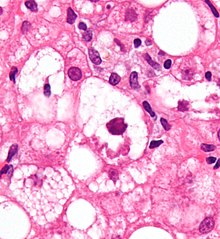Mallory body

Mallory corpuscles in a ballooned liver cell (center), HE staining .
So-called Mallory bodies are inclusion bodies in cells of the liver which were first described by the American pathologist Frank Burr Mallory (1862-1941). In order to honor the later contribution of the Graz pathologist Helmut Denk to their further research, the name Mallory-Denk-Body was suggested.
Mallory bodies occur in particular in alcohol-toxic hepatitis , but also occur in other diseases of the liver such as primary biliary cirrhosis or Wilson's disease . The mechanisms involved in formation are complex and include protein misfolding , changes in chaperone proteins and disproportionate expression of cytokeratins .
literature
- Pavelka & Roth: Mallory body in: Functional ultrastructure. Atlas of the biology and pathology of tissues. Springer Verlag, Vienna (2005) ISBN 3211835636 , page 140 full text
Individual evidence
- ↑ Mallory: Cirrhosis of the liver. Five different types of lesions from which it may arise. Bul Johns Hopkins Hosp 1911; 22: 69-75.
- ^ Zatloukal et al .: From Mallory to Mallory-Denk bodies: what, how and why? Exp Cell Res . 2007; 313: 2033-49, PMID 17531973 .
- ^ Strnad et al .: Mallory-Denk-Bodies: Lessons from keratin-containing hepatic inclusion bodies. Biochim Biophys Acta . 2008 Dec; 1782 (12): 764-74, PMID 18805482 .